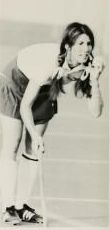Have you noticed that use of the hands have all but disappeared from hockey?

The rules for field players now only allow use of hands to hold the stick. Unofficially, of course, a hand pointed skywards is an appeal to the umpire for a free hit or an indication to the bench that you have run out of puff and need to be replaced.
It was not always thus. The hand could be used to stop the ball anywhere on the field, provided the hand was immediately moved out of the way and the ball was not propelled forward – similar to a knock on in rugby football. This applied to balls along the ground as well as balls in the air. The hand had to be motionless at the point of impact. Memory suggests that umpires had a poor understanding of physics. They seemed not to realise that the hand of a player jumping in the air would be momentarily motionless at peak height and just before the decent. Defenders who did understand physics always timed their jump to perfection so the hand was motionless at the point of impact.
The roll in to restart play when the ball went over the sideline was replaced with a push in the 1970s. Way back in the 19th century, the roll in had to be delivered at right angles to the sideline. Many of you will remember rolling the ball down the tram tracks. There was a line the length of the field, parallel to, and 7 yards from, the sideline. All players had to remain behind this 7 yard line until the ball was delivered, in theory along the ground. Understanding umpires usually allowed the roller a bit of leeway if the field was bumpy.
Records show that use of the hand, except by the goalkeeper, was abolished in 1984. This would have ended the hand trap on penalty corners which was one of the real skills of the game. Stopping the ball cleanly without propelling it forward and rapidly getting the hand out of the way without fingers being smashed by an uncaring, goal hungry fullback was one such skill. Another was to bounce the ball on the first corner of the match so the same uncaring fullback could hit the ball in the air on the fly before the umpire blew the offence. The theory was that the defenders would be discouraged from running out so fast next time.
